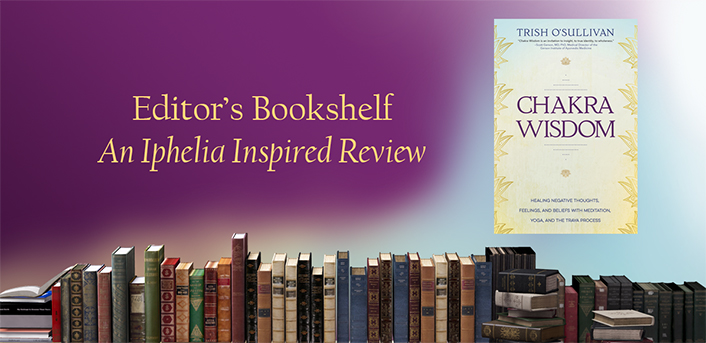
What can we learn about ourselves when we commit to reading a book we’re not 100 percent on board with at the start?
Well—a lot—especially if it’s anything like Trish O’Sullivan’s Chakra Wisdom: Healing Negative Thoughts, Feelings, and Beliefs with Meditation, Yoga, and the Traya Process.
I chose Chakra Wisdom for my November book review because…chakras (energy centers in the subtle body that have their place in “Eastern” philosophy, Jungian psychology, and beyond). I was first introduced to guided chakra meditations in January of 2017, and last November I started my now-regular yoga practice in a chakra balancing class. I’ve also gotten to edit chakra-centric pieces and tap into “chakra energy” in hypnotherapy and breathwork sessions.
Chakra theory (and practice!) interests and inspires me, so of course I was eager to expand my aspirant chakra wisdom by tucking into a book that, at face value, is all about chakras, thoughts, feelings, beliefs, meditation, and even yoga.
What I found during my first 1:1 with Chakra Wisdom, however, was not what I expected.


Firstly, it’s an ambitious project in which O’Sullivan, a licensed psychotherapist, reveals her novel Traya process—a practice during which she works with clients to clear negative energy, traumatic memories, and hurtful conclusions from the chakras using a very specific formula.
Secondly, she claims the discovery of secondary and tertiary chakras that aren’t part of other chakra systems.
My response to all this? Quite a bit of skepticism, especially given O’Sullivan’s assertion that “we don’t need to know anything about a chakra in order to work with it. In fact, we may get in our own way if we have too many preconceived ideas.”
This just didn’t compute for me. I was attracted to the book because I’m interested in chakras, and I assume that will be the case for many other readers, too. Her warning read like a tautology according to which all roads lead to Traya being “right.” Either it works for you, or something you learned about the chakras prior to reading the book is getting in the way of your healing.
This resistance was especially strong for me when it came to O’Sullivan’s early claims about the lower chakras’ associations with scenes from nature (according to which the wellbeing of a chakra is reflected by experiencing very specific scenes from nature when working with it). Having practiced chakra meditation for nearly two years, certain imagery, not all nature related, definitely comes to mind for me when engaging different chakras.

According to the information presented in the beginning of the book, this is indicative of some sort of problem—either in the chakras or with my chakra education thus far. That said, in the later chapters that make chakra-by-chakra suggestions for Traya practice, the “Scene from Nature” step is always marked as optional.
In addition to these mixed signals, O’Sullivan’s treatment of the solar plexus chakra is harsh to the point of being demonizing. The traditions I’ve encountered prior to reading Chakra Wisdom prioritize the healthfulness of all seven chakras, working from the ground up, and have never treated the solar plexus as problematic in itself.
O’Sullivan, however, treats the solar plexus as a sort of block-to-bliss that represents the id of Western society, with its insistence on “me first,” the intellect, willpower, drive, and fabricated binaries. I left the book wanting for fairer treatment of the solar plexus, or at very least a disclaimer these issues are more sociocultural than the “fault” of the chakra itself.

Finally, from a copy perspective, the edition I read (an advanced reader copy) included a number of grammatical errors and stylistic inconsistencies that I hope will be addressed in the print and digital editions. Only a few muddled O’Sullivan’s meaning, but the clearer and more consistent, the better!
So, what did I like about Chakra Wisdom and who is it best suited for?
O’Sullivan’s passion for the subject and care for people’s well-being is clear. The many anecdotes from her practice, in which she shares the heavy, deep, and real voices of her clients verbatim, are so rich, and to my mind it’s this material that really energizes the book. Reading people’s realizations during Traya sessions brought up plenty of material for me to work with and will put any introspective reader on the road to deeper thinking, even if they choose not to go the Traya road alone.
Ultimately, I came to appreciate the ideas O’Sullivan shared about the secondary chakras (which include imagination, fearless, release, true speech, and asking chakras, to name a few) and the attribute paradoxes she associates with the chakras (for example, in the throat chakra, “I talk a lot because I don’t feel heard and then am not heard because I talk a lot.”).
Anyone who’s interested in the chakras will benefit tremendously from this book—if they can hang on and get past the affronts to the ego that they might experience in the first few chapters. Therapists and clients interested in incorporating more chakra work into their sessions will also find a valuable resource and thoughtful inspiration in Chakra Wisdom’s pages.
Editor’s Bookshelf is a regular review of soon-to-be-released books that, in the spirit of Iphelia, asks important questions about how the written word—and in some cases, imagery—are used to help readers reconnect with their feelings, themselves, each other, and the world around them.
Iphelia’s editor, Linsey Stevens, answers these questions—chiming in on who will be most captivated by each book’s contents and how it invites readers to return to a heart-centered way of being.
Chakra Wisdom by Trish O’Sullivan will be available on December 8, 2018 from Llewellyn Publications. For more on O’Sullivan’s practice, visit www.trishosullivan.com. For more on Iphelia: Awakening the Gift of Feeling, visit our book page.

